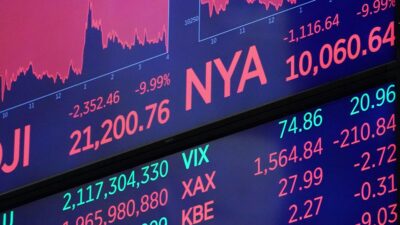Join the PU Xtrader Challenge Today
Trade with simulated capital and earn real profits after you pass our trader assessment.
Join the PU Xtrader Challenge Today
Trade with simulated capital and earn real profits after you pass our trader assessment.
*China set to impose retaliatory tariffs on the U.S., igniting global trade tension.
*Global equity markets, including Wall Street, European markets, and Asian markets, have faced significant selling pressure as the global trade war has escalated.
*Safe-haven currencies, including the Japanese Yen and Swiss Franc, gain as the market seeks shelter amid high trade tensions.
Market Summary
The global trade war appears to be in full swing after the U.S. government took the lead with sweeping tariffs on its major trade partners. In a swift response, China announced a retaliatory move, slapping a 34% tariff on all U.S. imports, effective April 10. The escalation sent shockwaves through global markets, triggering a broad selloff from Wall Street to European and Asian bourses.
At the open of the week, both the China A50 and Hong Kong’s Hang Seng Index gapped down by nearly 10%, a stark indication of investor panic and heightened uncertainty. As risk sentiment deteriorated, safe-haven assets saw strong inflows. Gold surged over 2%, climbing past the $3,000 mark as investors flocked to the traditional store of value. Similarly, the Japanese Yen and Swiss Franc appreciated sharply, while the U.S. dollar—now at the center of geopolitical and economic stress—lost significant ground. With the trade war still in its early stages, market volatility is expected to persist, likely keeping safe-haven currencies and gold well-supported in the near term.
In the digital asset space, the total cryptocurrency market cap dropped to its lowest level since President Trump’s re-election last November, reflecting broad-based risk aversion. Yet, Bitcoin (BTC) managed to hold above the $78,000 threshold, signaling relative resilience and growing perception as a digital safe-haven amid market turmoil.
Current rate hike bets on 7th May Fed interest rate decision:
Source: CME Fedwatch Tool
0 bps (63.5%) VS -25 bps (36.5%)
Market Movements
The U.S. Dollar Index staged a strong rebound from recent lows after Fed Chair Jerome Powell delivered a relatively hawkish tone in his post-NFP remarks last Friday. Powell emphasized that the Federal Reserve must remain vigilant and be prepared to respond to any resurgence in inflation—particularly in light of the inflationary risks tied to President Trump’s sweeping tariff policy. Technically, the Dollar Index is currently hovering near the 61.8% Fibonacci retracement level, a key zone often watched by traders for potential reversals or breakout confirmation.
The Dollar Index saw a technical rebound from its recent low but faced a strong resistance level at near 103.15. A break above should be a bullish trend reversal signal for the index. The RSI rebounded from the oversold zone, while the MACD has a golden cross at the bottom, suggesting that the bearish momentum has eased.
Resistance level: 104.70, 106.10
Support level: 101.75, 100.00
Gold prices swung wildly in the last session, reflecting heightened market uncertainty and shifting risk sentiment. After briefly plunging due to intense profit-taking and panic selling, the precious metal quickly regained traction following China’s announcement of retaliatory tariffs on the U.S.—a direct response to Washington’s sweeping protectionist measures. Despite the rebound, technical indicators suggest caution: a bullish structural break earlier signals that gold may, in fact, be shifting into a bearish phase.
Gold prices have turned bearish after the metal dipped below its previous low level and the critical psychological support level at the $3,000 mark. The RSI is approaching the oversold zone from the top, while the MACD has dropped below the zero line, suggesting that a bearish momentum is forming.
Resistance level: 3055.00, 3090.00
Support level: 3000.00, 2955.0
The British pound weakened notably against the U.S. dollar, with GBP/USD slipping below its previous low—signaling a bearish bias for the pair. The Sterling came under pressure after the UK’s PMI reading released last Thursday fell short of expectations, reinforcing concerns over slowing economic momentum in the region. Meanwhile, the greenback regained strength following a hawkish tone from Fed Chair Jerome Powell on Friday. In response to the rollout of sweeping tariffs by the Trump administration, Powell hinted that the Fed may need to maintain a restrictive policy stance to pre-empt any potential inflationary rebound. This shifted market expectations back toward a more hawkish Fed outlook, supporting the dollar.
GBP/USD is struggling to find support at the near 1.2875 mark. A break below this level should be a bearish signal for the pair. The RSI has gotten to near the oversold zone, while the MACD has a deadly cross on the above and is about to cross below the zero line, suggesting that the bullish momentum has vanished.
Resistance level: 1.2960, 1.3015
Support level: 1.2788, 1.2700
USD/JPY extended its decline to 144.95 as safe-haven demand for the yen grew amid rising risk aversion due to trade tensions. While a brief bounce followed stronger U.S. payrolls, the pair remained in a descending channel, reinforcing a bearish outlook. Falling Treasury yields and global uncertainty continue to weigh on the dollar, and Fed Chair Powell’s cautious stance. Meanwhile, weak consumption and declining real wages in Japan pressure the BOJ, though policy measures may soften the impact.
The USD/JPY pair is attempting to rebound after finding support near 143.66, now trading around 146.49. The bounce has sparked early signs of bullish momentum, with the RSI rebound from oversold territory and the MACD beginning to converge toward potential early signs of a bullish crossover. While upward pressure is building, momentum remains tentative.
Resistance level: 147.40, 149.00
Support level: 143.66, 140.66

EUR/USD is hovering near 1.0950, struggling to gain despite broad USD weakness as rising EU-U.S. trade tensions weigh on sentiment. The EU plans $28B in tariffs on U.S. goods, with internal divisions and fears of U.S. retaliation adding uncertainty. While markets still expect 100 bps in Fed cuts, Powell’s cautious tone may limit dovish expectations. Meanwhile, weak German data and Eurozone fragility could keep the ECB on a dovish path, capping EUR upside.
The EUR/USD pair is attempting to stabilize after a sharp pullback. The RSI has slipped from overbought territory indicating easing bullish momentum. Meanwhile, the MACD histogram has flipped slightly negative, with the MACD line crossing just below the signal line—signaling early signs of weakening upside pressure.
Resistance level: 1.1075, 1.1198
Support level: 1.0960, 1.0840
Crude prices plunged to their lowest levels in years, with WTI sinking below $60 amid renewed U.S.-China trade tensions and rising recession fears. Tariff escalations have darkened the demand outlook, while OPEC+ plans to ramp up production in May—alongside resilient Russian and U.S. output—have stoked fears of a supply glut. With bearish sentiment taking hold, near-term risks remain skewed to the downside, though geopolitical tensions could offer limited support. Crude appears vulnerable to further downside in the near term unless there’s a shift in trade policy or a significant supply disruption.
Prices remain under heavy pressure, now hovering near 60.48 after a sharp drop from the 70 zone. The break below multiple support levels reflects a strong bearish bias. RSI has plunged deep into oversold territory at 16, while the MACD remains negative, reinforcing the downside momentum. A hold above the 60 level could spark a short-term bounce, but a break below 59.50 risks deeper losses toward 57.41.
Resistance level: 64.00, 61.78
Support level: 59.52, 57.41
The NZD/CHF pair has slumped to its lowest level in over a decade, pressured by a confluence of bearish drivers that continue to weigh on the New Zealand dollar. As a proxy for Chinese economic sentiment, the Kiwi has come under renewed pressure after China unveiled a fresh round of retaliatory tariffs against the United States. The move not only escalates global trade tensions but also threatens to further strain China’s already fragile economic recovery—an outcome that has direct spillover effects on New Zealand’s export-driven economy. At the same time, growing expectations of a 25 basis point rate cut by the Reserve Bank of New Zealand (RBNZ) at Wednesday’s policy meeting have added further downside pressure. The anticipated move underscores the RBNZ’s dovish stance amid weakening domestic data and heightened global headwinds.
The NZDCHF has gotten to its decade low, suggesting a bearish bias for the pair. The RSI is rooted in the oversold zone, while the MACD has diverged after dropping below the zero line, suggesting that the bearish momentum is gaining.
Resistance level: 0.5615, 0.5665
Support level: 0.5544, 0.5465

Trade with simulated capital and earn real profits after you pass our trader assessment.

20 May 2025, 06:46 Gold Slips as Ceasefire Hopes Curb Safe-Haven Demand

7 May 2025, 03:59 Geopolitical Risks and FOMC Uncertainty Shake Global Markets

6 May 2025, 05:53 Dollar Dips, Gold Rallies on U.S.-Taiwan Risk

New Registrations Unavailable
We’re not accepting new registrations at the moment.
While new sign ups are unavailable, existing users can continue their challenges and trading activities as usual.